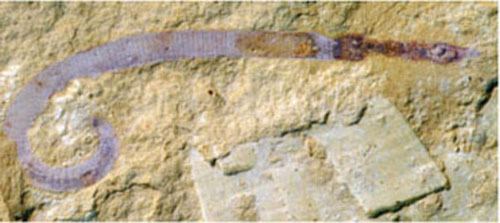Rank Class | ||
 | ||
Similar | ||
The palaeoscolecids are a group of extinct ecdysozoan worms resembling armoured priapulids. They are known from the Lower Cambrian to the late Silurian; they are mainly found as disarticulated sclerites, but are also preserved in many of the Cambrian lagerstätten. They take their name from the typifying genus Palaeoscolex.
Contents
Morphology
Palaeoscolecids bear an annulated trunk ornamented with circular patterns of phosphatic tesselating plates; a layered cuticle; and an armoured proboscis. They are long and narrow, and can reach tens of centimetres in length. Their cuticle is annulated, typically in complete rings, but sometimes the rings split or only encircle part of the trunk. Each annulus is essentially identical to its neighbours; the only trunk differentiation is at the anterior and posterior. The anterior is radially symmetrical, typically comprising an introvert, whereas the trunk is bilaterally symmetrical. The posterior hsots the terminal anus and sometimes one or two hooks. There is no one character that unites the palaeoscolecids as a clade (indeed they are likely paraphyletic), and few individual specimens contain all characteristic palaeosolecid traits.
Taxonomic position
Palaeoscolecids are a little tricky to define, and probably represent a paraphyletic grouping. Their most current systematic diagnosis references their annulated worm-like body form, the presence of rows (usually) of phosphatic plates, and a straight gut, with the anus at the end of the animal. The group contains a wide and continuous spectrum of morphological variety, making further division of the group difficult; moreover, non-palaeoscolecid taxa likely evolved from palaeoscolecid-like ancestors, and it is thus difficult to demarcate a single clade that corresponds to the palaeoscolecid concept.
They are considered to belong to the cycloneuralia, although their position within this group is unresolved; they may lie with the priapulids or nematomorpha. They have also been described as a sister-group to the ecdysozoa, although as more characters are described a position closer to the priapulids becomes most probable. A nematomorph affinity appears to be an artefact that results from under-sampling of the priapulid stem group. Their relationship with Archaeopriapulida is unclear, and either group may be paraphyletic to the other.
Other genera include Cricocosmia from the Lower Cambrian Chengjiang biota. Their relationship with the archaeopriapulida is also unclear; it could be that both groups are a paraphyletic assemblage containing the priapulids.
Taxonomy
As palaeoscolecids may represent a grade rather than a clade, drawing up a formal taxonomy proves problematic. What is more, two parallel taxonomies exist: a form taxonomy for sclerites, and a true taxonomy for articulated fossils. The most recent holistic study of priapulids by Harvey et al. (2010) defines a core of palaeoscolecids characterized by a cuticle that is made up of interlocking plates of multiple sizes, and a looser assemblage (palaeoscolecids sensu lato) including other unconfirmed and palaeoscolecid-like forms:
Articulated macrofossils
Articulated microfossils
(from Orsten-type deposits, preserved in three dimensions)
Palaeoscolecidae From Australia
From China
Palaeoscolecids sensu lato
Other long and narrow Palaeozoic worms that exhibit an invariant body width are commonly referred to the palaeoscolecids, even though they lack the cuticular structure that defines the group; this 'Palaeoscolecid sensu lato' group includes Louisella, Cricocosmia, Tabelliscolex, Tylotites and others. Maotianshania and, by extension, the family Maotianshaniidae, was excluded from the "Palaeoscolecids sensu strictu" by Harvey et al. (2010), but it has been argued that members of this family do exhibit the requisite cuticular structure, if discreetly.
Status impossible to determine from current material
It's possible that Markuelia represents an embryonic Palaeoscolecid.
Linnean taxonomy
Palaeoscolex
Palaeoscolex has been abused as a wastebucket taxon for palaeoscolecid macrofossils. The most recent proposal is that Palaeoscolex should only include taxa with Milaculum-type sclerites, as in the type species P. piscatorum. As such, P. ratcliffei and P. huainanensis should not be included in Palaeoscolex.
Wronascolex
Originally described from Siberia, Wronascolex should now be considered to include all taxa with Hadimopanella sclerites that have 3–10 nodes in a single circle, perhaps including Yunnanoscolex.
Guanduscolex, Wudingscolex
Though these genera have sclerites that resemble Hadimopanella knappologicum, they remain valid genera.
Mafangscolex
This genus has simple sclerites with a single (small but prominent) node in the middle, so can be separated from Palaeoscolex(unless this simplicity is taphonomic).
